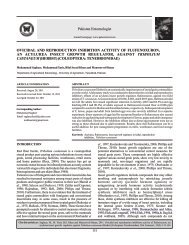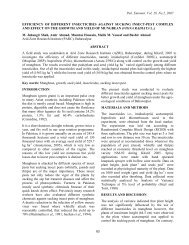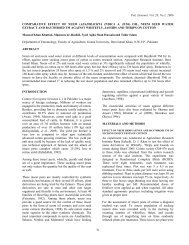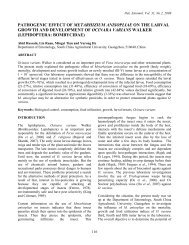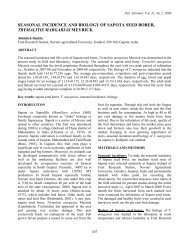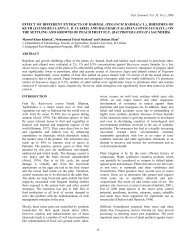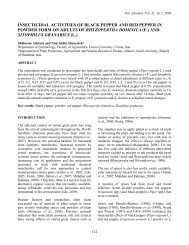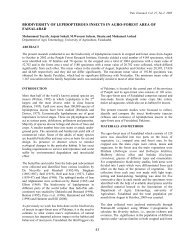SYMPHEROBIUS FALLAX NAVAS
SYMPHEROBIUS FALLAX NAVAS
SYMPHEROBIUS FALLAX NAVAS
You also want an ePaper? Increase the reach of your titles
YUMPU automatically turns print PDFs into web optimized ePapers that Google loves.
Pak. Entomol. Vol. 31, No.1, 2009STUDIES ON THE FEEDING PREFERENCE OF BROWN LACEWING (<strong>SYMPHEROBIUS</strong> <strong>FALLAX</strong><strong>NAVAS</strong>) LARVAE FOR DIFFERENT STAGES OF LONG-TAILED MEALY BUG (PSEUDOCOCCUSLONGISPINUS) (TARGIONIAND TOZZETTI)Waseem. A. Gillani, Mike Copland * and Shazia Raja **Institute of Plant and Environmental Protection, NARC, Islamabad.* Department of Environment, WYE College, University of London. U.K.** Honeybee Research Institute, NARC, Islamabad.ABSTRACTPseudococcus longispinus (Targioni-Tozzetti) has a wide distribution in tropical and subtropical regions of theworld. It attacks many fruit trees, crop plants, vegetables and ornamentals as well as greenhouse plants.Experiments were done to determine the feeding preference of brown lacewing Sympherobius fallax (Navas)larvae of different stages on long-tailed mealy bug Pseudococcus longispinus. It was found that in the no choiceexperiment the first-instar Sympherobius fallax (Navas) consumed second-stage mealy bug more than any otherstages and did not eat fourth (adult) stage while second-stage S. fallax preferred third-stage mealybugs. ThirdstageS. fallax also preferred third-stage mealybugs. In the choice experiment the first-stage larval predatorspreferred second-stage mealybugs significantly more than the other two stages while the second- and third-stagepredators preferred third-stage mealybug significantly more than the second and the fourth stages. It was alsodetermined that darkness has a marked effect on the feeding efficiency of all stages of S. fallax. The number ofmealy bugs eaten in the light was significantly greater than in the darkness in all the stages of S. fallax.Key Words: mealy bug, feeding, lacewing, larval instarINTRODUCTIONPrey preference can be an important factor in thesuccess of a polyphagous predator in a bio-controlprogramme. It is particularly important for the targetpest to be among the preferred prey. A key factor forsuccessful bio-control using the predatory insects isknowledge of feeding preference, food specificity,alternative food sources and the predator’s feedinghabit (Thompson, 1951). On hatching from the egg,the first-instar larvae of some Chrysopidae retainremnants of the yolk in their gut, sufficient to nourishthem during the first hours of their independent life.However, most species appear not to have this, andtheir resistance to starvation and minimum foodrequirements during this period determines theirability to survive at low prey densities (New, 1975).Carter (1949) reported that the larvae of thehemerobiid species, Drepanacra binocula Newsman,while predating on the pittosporum chermid Powelliavitreoradiata Mast, in New Zealand, preferred fourthand fifth instars. Dunn (1954) investigated Micromusvariegatus Fabr. (Neuroptera: Hemerobiidae) as apredator of the aphid Acyrthosiphon pisum (Harris),and found that it preferred second and third instars.Kapadia and Puri (1991) showed that younger stagesof mirid predators Deraeocoris sp. andCamplylomma nicolasi Reuter preferred young larvaeof the whitefly Bemisia tabaci Genn., whilst the olderpredators fed on any immature stage. The quantity ofprey eaten by chrysopid predators in a situation whenfood is abundant is not well-known as it is difficult tomeasure accurately and the data imply considerablevariability. Generally more than three quarters of thetotal consumption occurs in the third-instar (Canardet al., 1984). Darkness has a significant effect on thebiology of insects. Some insects are active in brightsunshine, some are active at low light intensity, whilesome are active in the darkness. Few laboratorystudies have examined the effect of light on thebehaviour of predators. Banks (1957) showed thatcoccinellid larvae made only limited movements inthe dark but in the light these were three and a halftimes more frequent and three times faster than in thedark, whereas chrysopid larvae were more efficient indimly-lit areas. Occasionally the effect of darknesson various insects has been reported but rarelystudied in detail (Huyton and Brady, 1975). Thereappears to have been no reports on the effect ofdarkness on the feeding potential of brown1
Pak. Entomol. Vol. 31, No.1, 2009lacewings. The prey P. longispinus female has fouractive stages. This study examines the preferred preystage for each stage of the predator and investigatesthe effect of complete darkness on the feedingefficiency of different instars of brown lacewing, S.fallax (Navas).MATERIALS AND METHODSThree experiments were conducted to observe thefeeding behaviour of larval stages of S. fallax whilepredating on different stages of the long-tailed mealybug, P. longispinus. The experiments were conductedin 4.5 cm diameter petri-dishes. For each experiment,three different stages of the brown lacewing (first-,second-, and third-stage larvae) were collected fromthe main stock culture of the Wye College, glasshouses, U.K and kept singly in 5 ml glass vials for 24hours of starvation prior to the beginning of eachexperiment. The experiments were conducted inincubators at 26°C, 65% R.H. and 7.5 watts/ m 2 ofcontinuous illumination. For each stage of thepredator, the data obtained for feeding in choice andno-choice experiments were analysed through onewayANOVA at 5% level. The means of twoillumination treatments were compared with twosample t-test at 5% level.Effect of ‘no choice’ on the feeding of S. fallaxlarvaeIn this experiment, the predator had no choice for theselection of a host stage for feeding because only aspecific mealy bug stage was offered to it. Twenty P.longispinus mealy bugs of a particular stage werereleased on to a clean avocado leaf-disc placed onagar in each petri-dish with a single larva of aparticular stage of the predator. There were twentyreplicates of each mealy bug stage and for each instarof the predator. The number of individuals of eachstage of mealy bug eaten by each stage of predatorwas recorded after twenty-four hours.Effect of ‘choice’ on the feeding of S. fallax larvaeFor this experiment, the brown lacewing larvae wereallowed to predate upon the mealy bug stage of theirchoice. Avocado leaves infested with all stages oflongtailed mealy bug were collected. Leaf-discs of4.5 cm in diameter were carefully cut from infestedleaves and placed singly on the agar medium alreadypoured in the petri-dishes. The numbers ofindividuals of each mealy bug stage present on eachleaf-disc were counted before the start. One brownlacewing larva was released in each petri-dish. Therewere five replications for each instar of brownlacewing. The numbers of individuals of each mealybug instar eaten by the brown lacewing larvae in eachreplicate were noted after 24 hours.Effect of complete darkness on the feeding of S.fallax larvaeTwenty uniform-size larvae of first-, second-, andthird-instars of brown lacewing S. fallax werecollected from the main culture and transferred singlyinto 5 ml vials. The vials were divided into twogroups of ten larvae of each stage for conditioning inthe dark. One group of larvae was kept in completedarkness in an incubator set at 26°C, 65% R.H. andthe other group in a different incubator set at 26°C,65% R.H. and 7.5 watts / m 2 light intensity. Theywere provided with sufficient P. longispinus mealybugs to feed upon. The lacewing larvae were keptstarved for 24 hours prior to the beginning of eachexperiment. The tests were conducted in 4.5 cmdiameter petri-dishes containing an avocado leaf-discplaced on agar medium. Each petri-dish contained tenP. longispinus and one S. fallax larva of a particularstage. The first-instar brown lacewings were offeredsecond-instar mealy bugs whereas second- and thirdinstarlacewing larvae were provided with third-instarmealy bugs. The sets were placed in their respectivedark and light conditions in two different incubators,as described. The numbers of mealy bugs eaten wererecorded after 24 hours. To know the quantity (inweight) of mealy bugs eaten during 24 hours, themealy bugs were weighed before the start and leftovermealy bugs were weighed after the experimenton an electronic microbalance. The data obtainedwere statistically analysed through ANOVA at 5%level.RESULTS AND DISCUSSIONEffect of ‘no choice’ on feeding of S. fallax larvaeIn no choice experiment the first-instar S. fallaxconsumed second-stage mealy bug more than anyother stages and did not eat fourth (adult) stage (P
Pak. Entomol. Vol. 31, No.1, 2009findings are similar to those of Tauber and Tauber(1972) and Canard (1990) who found that darknessslows the activities of chrysopid predators. It couldbe concluded from these studies that third-instar P.longispinus is the most preferred stage and that thefourth-stage (adult stage) is the least preferred asfood. Darkness was also found to affect the feedingbehaviour of S. fallax larvae which ate significantlyfewer mealy bugs in the dark.REFERENCESBanks, C. J., 1957. The behaviour of individualcoccinellid larvae on plants. British J. Anim.Behv., 5: 12-24.Canard, M., Y. Semeria and T. R. New, 1984.Biology of Chrysopidae. Dr. W. Junkpubl.Hague, 294 pp.Canard, M., 1990. Effect of photoperiod on the firstinstardevelopment in the lacewing Ninetapallida. Physiol. Entomol., 15: 137 - 140.Carter, M. W. 1949. The pittosporum chermid,Powellia vitreoradiata Mask. New Zeeland J.Sci. Tech., 31: 31 - 42.Dunn, J. A., 1954. Micromus variegatus Fabricius(Neuroptera) as a predator of the pea aphid.Proceed. Royal Entomol. Soci. London, A., 29:76 - 80.Huyton, P. M. and J. Brady, 1975. Some effects oflight and heat on the feeding and restingbehaviour of Tsetse Flies. Glossina morsitansWestw. J. Entomol. (A), 50: 21-23.Kapadia, M. N. and S. N. Puri, 1991. Biology andcomparative predation efficacy of threeheteropteran species recorded as predators ofBemisia tabaci in Maharashtra. Entomophaga,36: 555-559.New, T. R., 1975. The biology of Chrysopidae andHemerobiidae (Neuroptera), with reference totheir usage as biocontrol agents: a review. Trans.Royal Entomol. Soci. London, 127: 115 - 140.Tauber, M. J. and C. J. Tauber., 1972. Geographicvariation in critical photoperiod and in diapauseintensity of Chrysopa carnea (Neuroptera).Insect Physiol., 18: 25 - 29.Thompson, W. R., 1951. The specificity of hostrelation in predacious insects. Can Entomol., 83:262 - 269.4



